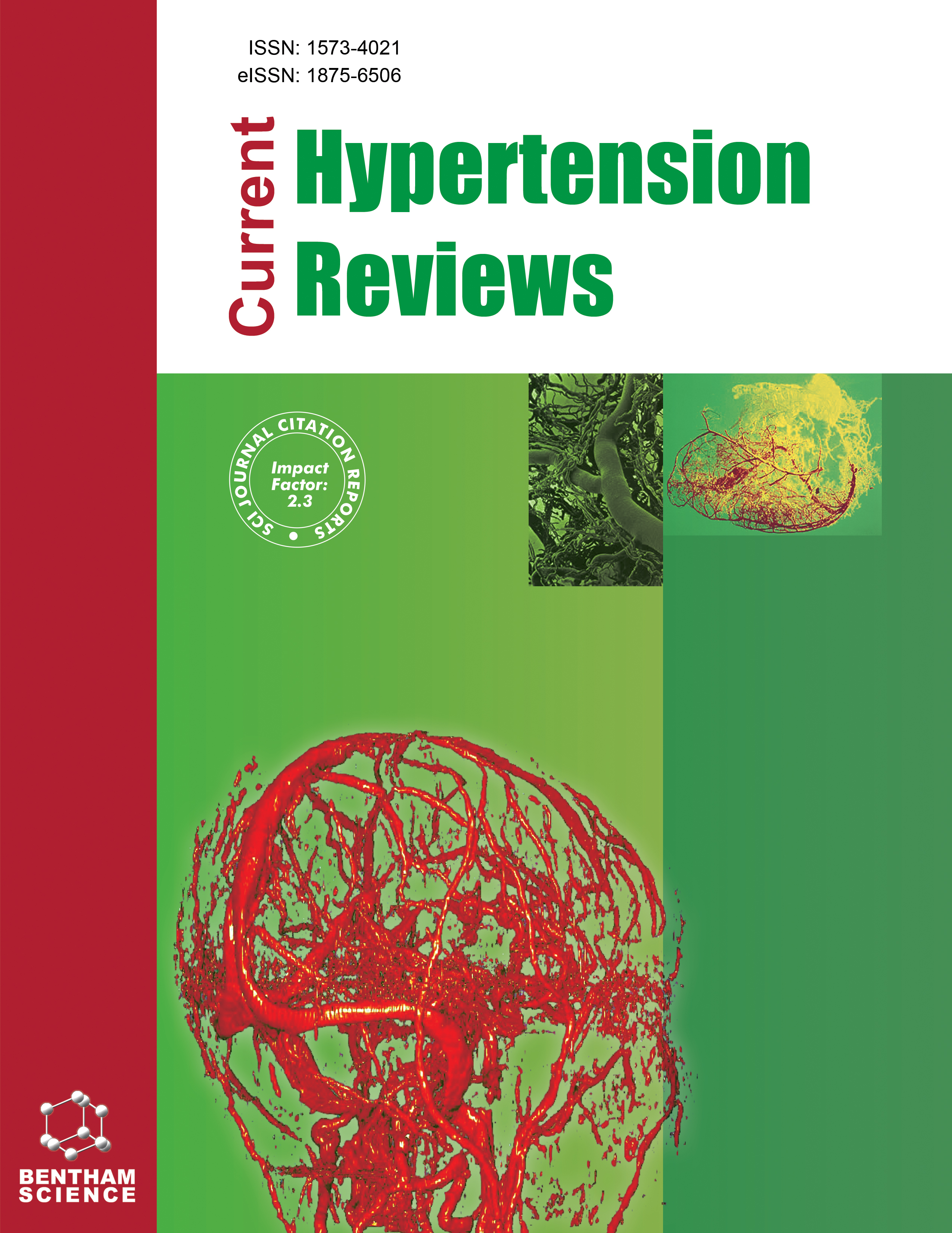- Home
- A-Z Publications
- Current Hypertension Reviews
- Previous Issues
- Volume 9, Issue 2, 2013
Current Hypertension Reviews - Volume 9, Issue 2, 2013
Volume 9, Issue 2, 2013
-
-
Do RAS Inhibitors Protect the Brain from Cerebral Ischemic Injury?
More LessAuthors: Naohisa Hosomi, Akira Nishiyama and Masayasu MatsumotoIn addition to centrally regulating electrolyte homeostasis and blood pressure, angiotensin IIhas various general effects on the central nervous system. The existence of renin-angiotensin system components in the brain has been well established. Angiotensin II and other renin-angiotensin system components are synthesized and distributed throughout the brain. Post-ischemic oral administration of a non-hypotensive dose ( Read More
-
-
-
RAS Inhibition Attenuates Cognitive Impairment by Reducing Blood- Brain Barrier Permeability in Hypertensive Subjects
More LessAuthors: Nicolas Pelisch, Naohisa Hosomi, Hirohito Mori, Tsutomu Masaki and Akira NishiyamaRecent studies have suggested that blood-brain barrier (BBB) abnormalities are present from an early stage in patients exhibiting mild symptoms of cognitive impairment during the development of hypertension. There is also growing body of evidence suggesting the potential role of the renin-angiotensin system (RAS) in the pathogenesis of small-vessel disease and cognitive impairment. However, the specific contribution of th Read More
-
-
-
Renoprotective Effects of the L-/T-type Calcium Channel Blocker Benidipine in Patients with Hypertension
More LessThe renoprotective effects of benidipine, a calcium channel blocker (CCB) developed in Japan, are reviewed herein. Benidipine has a sustained antihypertensive effect independent of its blood concentration since it binds to dihydropyridine (DHP) receptors via a “membrane approach” (approach to the cell membrane followed by long retention at the DHP binding site). Benidipine dilates glomerular afferent and efferent Read More
-
-
-
Rationale and Design of an Observational Study to Determine the Effects of Cholecalciferol on Hypertension, Proteinuria and Urinary MCP-1 in ADPKD
More LessAuthors: Gopala K. Rangan and David C. HarrisAutosomal dominant polycystic kidney disease (ADPKD) is the most common genetic cause of kidney failure in the world. Currently there are no treatments to prevent kidney due to ADPKD. Vitamin D is traditionally known for its role in maintaining calcium balance and normal bone health, but it is being increasingly being recognised for a number of other important physiological functions, including reducing blood pressure a Read More
-
-
-
Interactions Between the Sympathetic Nervous System and Angiotensin System in Renovascular Hypertension
More LessAuthors: Nishigandha Pradhan and Noreen F. RossiRenal artery stenosis especially that due to atherosclerotic peripheral vascular disease is increasing in the population. The role of the renin angiotensin aldosterone system in the pathogenesis of renovascular hypertension is widely accepted. There is increasing recognition of the role of the sympathetic nervous system, from both afferent and efferent signaling pathways, as a contributor to development of hypertension. I Read More
-
-
-
The Promises and Challenges of the Use of Genomics in the Prescription of Exercise for Hypertension: The 2013 Update
More LessAuthors: Garrett I. Ash, John D. Eicher and Linda S. PescatelloHypertension is a major global public health problem, resulting in over 7.6 million deaths per year (13.5% of the total), more than any other cardiovascular disease risk factor. Exercise decreases blood pressure (BP) 5-7 mmHg among those with hypertension. Thus, the American College of Sports Medicine recommends the exercise prescription (ExRx) of 30 min or more of moderate intensity, aerobic activity on most days Read More
-
-
-
Roles of Renal Proximal Tubule Transport in the Pathogenesis of Hypertension
More LessAuthors: Shoko Horita, George Seki, Hideomi Yamada, Masashi Suzuki, Kazuhiko Koike and Toshiro FujitaHypertension is a key factor of cardiovascular disease. Many organs and systems including heart, blood vessel, kidney, sympathetic nerve, and endocrine systems are involved in the regulation of blood pressure. In particular, the kidney plays an essential role in the regulation of blood pressure, but is also quite vulnerable to hypertensive tissue damage. For example, most chronic kidney disease (CKD) patients have hyp Read More
-
-
-
Diagnosis and Treatment of Unilateral Forms of Primary Aldosteronism
More LessPrimary aldosteronism (PA) is now recognized as the most frequent form of secondary arterial hypertension. The importance of a correct and prompt diagnosis of PA is determined by its relevant prevalence, its increased cardiovascular risk compared to essential hypertension and by the possibility of reversing this increased risk with a targeted therapy. Surgical treatment of unilateral forms of PA (mainly aldosterone-prod Read More
-
Volumes & issues
-
Volume 21 (2025)
-
Volume 20 (2024)
-
Volume 19 (2023)
-
Volume 18 (2022)
-
Volume 17 (2021)
-
Volume 16 (2020)
-
Volume 15 (2019)
-
Volume 14 (2018)
-
Volume 13 (2017)
-
Volume 12 (2016)
-
Volume 11 (2015)
-
Volume 10 (2014)
-
Volume 9 (2013)
-
Volume 8 (2012)
-
Volume 7 (2011)
-
Volume 6 (2010)
-
Volume 5 (2009)
-
Volume 4 (2008)
-
Volume 3 (2007)
-
Volume 2 (2006)
-
Volume 1 (2005)
Most Read This Month
Article
content/journals/chyr
Journal
10
5
false
en


